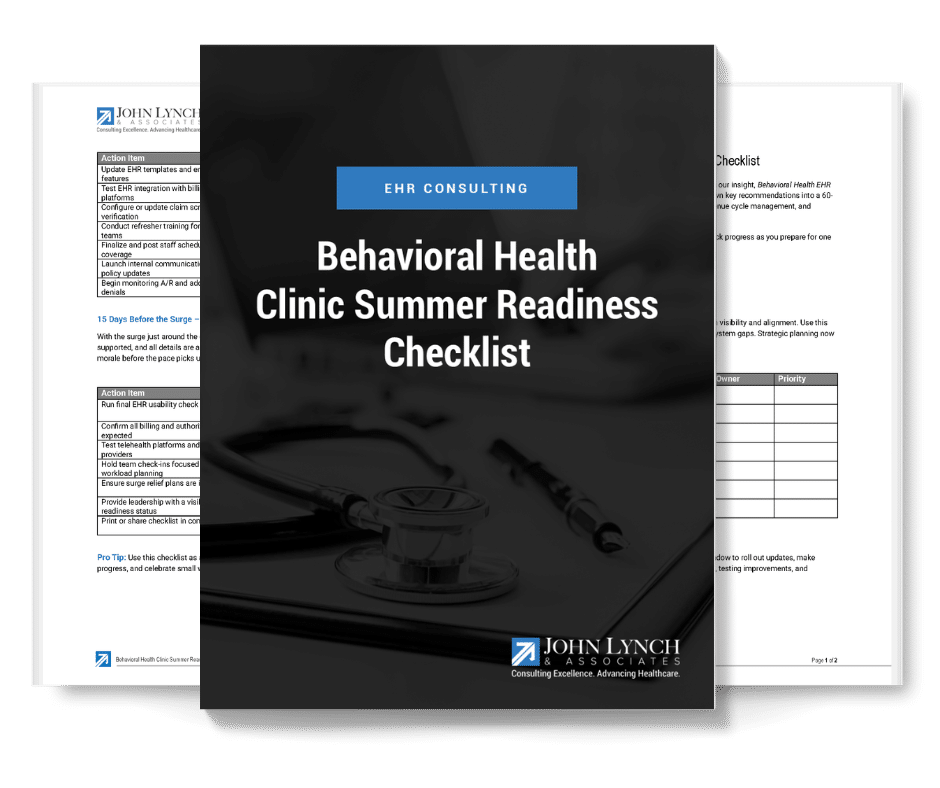Spring may feel like a welcome pause for behavioral health clinics but it’s also the perfect moment to prepare for what’s ahead. As the weather warms, so does demand. Each summer, clinics across the country face a surge in patient volume driven by rising mental health needs in youth, increased appointment availability, and intensified treatment planning before the back-to-school season.
But preparation isn’t just about scheduling more sessions. It’s about strengthening your infrastructure your EHR system, your revenue cycle, and your workforce to prevent the kind of breakdowns that can erode care quality and staff morale.
Too often, clinics enter the summer rush in reaction mode. Clinicians find themselves overwhelmed with documentation. Claims are denied or delayed, stretching cash flow. Staff burnout begins to rise just as the need for services peaks. In a field already marked by emotional labor and limited resources, that pressure can feel unsustainable.
That’s why the time to act is now.
By taking a proactive approach this spring, behavioral health leaders can position their organizations to absorb the seasonal increase in patient volume without compromising care, efficiency, or team well-being. In the pages ahead, we’ll walk through practical strategies to optimize your electronic health record system, improve the reliability of your revenue cycle, and prepare your staff for high-volume months along with a downloadable checklist to help your team get ready, step by step.
With the right systems and supports in place, your clinic can move into summer not just prepared but empowered to serve your community at full capacity.
- 1. Why Behavioral Health Clinics Must Prepare for the Summer Surge
- 2. Step #1: Optimizing Your EHR for Peak Efficiency
- 3. Step #2: Strengthening Your Revenue Cycle to Prevent Financial Bottlenecks
- 4. Step #3: Preparing Your Workforce for Increased Demand
- 5. Your Behavioral Health Clinic Summer Readiness Checklist
- 6. A Proactive Approach to a Successful Summer
- 7. Related Articles
- Seasonal surges in mental health services can overwhelm unprepared clinics spring is the ideal time to proactively strengthen your operations.
- Optimizing EHR workflows can reduce clinician burden, improve documentation accuracy, and support higher patient volume.
- Strengthening your revenue cycle before summer helps prevent claim denials, cash flow disruptions, and administrative bottlenecks.
- Workforce planning including scheduling, training, and emotional support helps staff stay resilient during high-demand months.
- A free, downloadable Summer Readiness Checklist offers actionable steps and a timeline to guide your preparation efforts.
Why Behavioral Health Clinics Must Prepare for the Summer Surge
For behavioral health clinics, summer doesn’t just bring sunshine it brings complexity. From June through August, patient volume often rises sharply as families adjust schedules, students are out of school, and clinicians seek to complete treatment plans before the academic year resumes. While this seasonal increase is predictable, its operational impact can still catch teams off guard.
More appointments mean more documentation, more billing, more coordination, and more opportunities for things to slip through the cracks. For organizations already managing tight margins and stretched teams, that additional strain can create ripple effects that reach every corner of care delivery.
One of the most significant stressors is the gap between patient demand and operational readiness. Many clinics are still operating with EHR workflows that haven’t been reviewed or refined in years. These systems might function “well enough” in quieter months, but under pressure, inefficiencies show up fast.
Providers spend more time charting, which cuts into face time with patients and increases the risk of burnout. Administrative teams struggle to keep pace with billing and authorizations. And small errors missed documentation fields, outdated payer rules, scheduling mishaps start to stack up into bigger problems.
On the financial side, summer can also expose weaknesses in revenue cycle management. When claims increase but processes aren’t streamlined, denials and delays multiply. That can strain cash flow when you need to pay overtime, bring in backup staff, or extend clinic hours to meet demand.
Clinics that aren’t financially prepared may find themselves in a cycle of high output and delayed input, which can be demoralizing and unsustainable.
And then there’s the workforce. Staff often request time off during summer, making scheduling even more complex. At the same time, clinicians may experience heavier emotional loads as they support clients with intensified needs particularly youth and families navigating trauma, transitions, or crises.
Without proper planning, support, and coverage, your team may start the summer with good intentions and end it feeling depleted.
None of these challenges are new. But that’s exactly why they’re manageable if addressed early.
By anticipating the pressure points ahead of time, behavioral health leaders can create a plan that supports both operational resilience and clinical excellence. That begins with optimizing the very tools your team uses every day.

Step #1: Optimizing Your EHR for Peak Efficiency
Your electronic health record (EHR) system is the nervous system of your clinic. When it's running smoothly, it connects everything: intake, clinical documentation, billing, reporting, and communication. But when it's inefficient or poorly aligned with behavioral health workflows it can quickly become a barrier instead of a support.
That’s especially true during high-demand periods like summer, when every click, keystroke, and delay compounds across your team.
Preparing for the summer surge means asking a critical question: Is our EHR working for us or against us?
For many behavioral health clinics, the answer is mixed. Systems were implemented with the best intentions, but over time, they haven’t kept pace with how care is delivered. Providers often adapt to inefficient workflows instead of correcting them, which leads to longer documentation times, more copy-pasting, and increased risk of burnout.
Spring is an ideal time to step back and evaluate: Where is the system slowing us down? Where can we simplify, automate, or standardize processes to save time and reduce frustration?
One of the most impactful places to start is with documentation workflows. Behavioral health encounters tend to be note-heavy, and without tailored templates, providers can spend an extra 5–10 minutes per session on charting.
Multiply that across a full caseload, and you're looking at hours of lost clinical time each week. Streamlining documentation processes to better reflect provider needs can dramatically improve both efficiency and satisfaction.
Beyond templates, automation features like auto-fill, smart phrases, and embedded prompts reduce cognitive load and make documentation more intuitive. And if your EHR doesn’t integrate well with scheduling, billing, or telehealth platforms, your team may be wasting time on duplicate entry or manual workarounds time they won’t have when patient demand peaks.
Reducing administrative burden isn’t just about speed it’s about supporting clinician well-being. When providers feel empowered by the tools they use daily, they're more likely to stay engaged and focused on care delivery.
According to federal guidelines for optimizing EHR systems, aligning technology with real-world clinical workflows is one of the most effective ways to reduce burnout and improve care quality.
Taking time now to refine your EHR system whether through smarter templates, better automation, or tighter integration can significantly lighten the load before demand spikes. Even modest improvements to usability can create noticeable gains across your clinic once summer arrives.
Step #2: Strengthening Your Revenue Cycle to Prevent Financial Bottlenecks
While patient care often takes the spotlight during seasonal surges, your clinic’s financial infrastructure needs just as much attention. A well-functioning revenue cycle is what ensures you can continue delivering care even when demand, complexity, and workload increase.
If billing delays, denials, or outdated processes creep in during peak season, they can quickly compromise your clinic’s stability.
Summer’s higher volume doesn’t just mean more sessions it means more claims, more coordination with payers, and more chances for something to slip through the cracks. Clinics that haven’t evaluated their revenue cycle in months (or even years) often find that inefficiencies are quietly draining time and revenue.
The most common issue? Preventable claim denials. Missing prior authorizations, inaccurate diagnosis codes, or simple demographic errors can delay reimbursement by weeks. During busy seasons, these delays multiply.
A backlog of denials puts pressure on administrative staff, delays income, and strains your ability to pay overtime or bring in support staff when needed.
Now is the time to tighten that process.
Start by auditing your current claims process. What’s your denial rate? Are denials clustered around specific services, payers, or staff? A quick diagnostic can reveal where you’re losing revenue and where to intervene.
From there, consider streamlining front-end verification, updating payer rule databases, and conducting refresher training for staff who handle authorizations and coding.
Technology can also play a powerful role. Automating eligibility checks, claim scrubbing, and real-time error flagging can help your team avoid costly mistakes and move claims through faster.
Even basic process automation like batching claims or generating payment reminders can boost your collections significantly over a three-month period.
To see the kind of results this approach can deliver, look at our case study on transforming a behavioral health revenue cycle department. In it, you’ll find practical insights into how improved oversight, clearer workflows, and targeted support led to measurable gains in reimbursement speed, staff efficiency, and financial performance.
Revenue cycle improvements don’t have to be massive to be meaningful. A few focused adjustments now can prevent a ripple effect of missed payments and administrative overwhelm when your clinic is at its busiest.

Step #3: Preparing Your Workforce for Increased Demand
Your systems can only carry your clinic so far your people are the ones who ultimately carry the surge. When summer hits and appointment requests spike, your team becomes your greatest asset or your greatest vulnerability.
Without proactive planning, even the best clinicians and support staff can feel stretched thin, leading to fatigue, errors, and decreased morale.
Summer presents a unique challenge. Staff members often request time off, reducing availability just as demand peaks. Meanwhile, the patients coming in often have more acute needs particularly adolescents and families navigating transitions, trauma, or intensified behavioral challenges over the break.
That emotional load, combined with a packed schedule, can quickly lead to burnout if teams aren’t supported.
Preparation begins with honest scheduling assessments. Take a close look at upcoming PTO requests, planned leaves, and coverage gaps. Can you shift workloads to balance caseloads more equitably? Are there opportunities to bring in part-time or per diem clinicians to help shoulder the volume?
It’s also a good time to evaluate training needs. When intake coordinators, billing staff, and front-desk teams are aligned, the entire clinic runs more smoothly. A quick spring training refresh focused on new payer rules, EHR workflows, or updated scheduling protocols can prevent costly errors when things get busy.
Beyond logistics, it’s important to focus on provider well-being. High-volume months can lead to emotional exhaustion, especially in behavioral health settings where the work is already deeply personal.
Create space now to talk openly about stress, workload, and support strategies. Consider check-ins, schedule flexibility, or “no-meeting” blocks that allow clinicians to breathe between sessions.
And don’t underestimate the role of telehealth. Even a partial shift to virtual care can help clinics absorb more volume without adding pressure to on-site staff. Whether it’s for follow-ups, medication management, or family counseling, virtual visits create space while maintaining access to care.
The key is to treat workforce planning with the same strategic importance as systems optimization. When staff feel prepared, seen, and supported, they’re not only more effective they’re more resilient.
That’s what makes the difference between just getting through the summer and thriving in it.
Your Behavioral Health Clinic Summer Readiness Checklist
By now, it’s clear that preparing for the summer surge isn’t about doing one big thing it’s about doing the right small things, at the right time.
That’s why we created a free Behavioral Health Clinic Summer Readiness Checklist a simple, actionable guide you can use to get ahead of the seasonal curve.
This resource is designed to help your leadership team assess readiness across the three critical areas we’ve covered: EHR optimization, revenue cycle improvements, and workforce planning. Whether you’re a clinical director, operations lead, or executive, this checklist gives you a clear starting point for meaningful conversations and smart decisions.
What’s inside the checklist:
- Key action items for streamlining EHR workflows and reducing clinician burden
- Financial checkpoints to prevent billing delays and claim denials
- Staffing and training strategies to ensure adequate coverage and support
We’ve also included a simple timeline what to address 60, 30, and 15 days before peak season so you can pace your improvements without overwhelming your team.

A Proactive Approach to a Successful Summer
Every behavioral health clinic feels the pressure when summer arrives but not every clinic has to feel overwhelmed by it. By taking a proactive approach now, you can reduce friction, support your staff, and set your organization up for a season of smoother operations and better patient outcomes.
We’ve walked through three core strategies that work together to build that readiness: optimizing your EHR to ease documentation and streamline care, strengthening your revenue cycle to ensure financial stability, and preparing your workforce to manage increased demand with resilience, not burnout.
None of these steps require a full system overhaul. Small, targeted improvements made now before the seasonal spike can translate into measurable gains when it matters most.
If you’re looking for a place to start, we invite you to download the free Summer Readiness Checklist. It’s practical, actionable, and built specifically for behavioral health leaders who want to lead with intention and clarity through the busiest time of year.
And if your organization could use support from optimizing EHR workflows to transforming your revenue cycle, John Lynch & Associates is here to help. Let’s work together to make this your most prepared summer yet.
Ready to Talk?
Related Articles

Audit Readiness in Behavioral Health: How Compliance Officers Lead Beyond the Checklist

3 Strategies to Improve Behavioral Health Financial Stability


